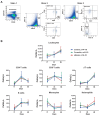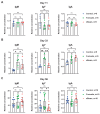Electron-Beam-Killed Staphylococcus Vaccine Reduced Lameness in Broiler Chickens
- PMID: 39591106
- PMCID: PMC11598142
- DOI: 10.3390/vaccines12111203
Electron-Beam-Killed Staphylococcus Vaccine Reduced Lameness in Broiler Chickens
Abstract
Broiler chicken lameness caused by bacterial chondronecrosis with osteomyelitis (BCO) is presently amongst the most important economic and animal welfare issues faced by the poultry industry, and the estimated economic loss is around USD 150 million. BCO lameness is associated with multiple opportunistic bacterial pathogens inhabiting the respiratory and gastrointestinal tracts. In cases of immune deficiency resulting from stress, injury, or inflammation of the tissue, opportunistic pathogens, mainly Staphylococcus spp., can infiltrate the respiratory or gastrointestinal mucosa and migrate through the bloodstream to eventually colonize the growth plates of long bones, causing necrosis that leads to lameness. This is the first report of developing a Staphylococcus vaccine against BCO lameness disease in broiler chickens. Electron beam (eBeam) technology causes irreparable DNA damage, preventing bacterial multiplication, while keeping the epitopes of the cell membrane intact, helping the immune system generate a more effective response. Our results show a 50% reduction of lameness incidence in the eBeam-vaccinated chicken group compared to the control. Additionally, the eBeam-vaccinated chickens present higher titer of anti-Staphylococcus IgA, signifying the development of an efficient and more specific humoral immune response. Our data establish the eBeam-killed Staphylococcus vaccine as an effective approach to reducing the incidence of lameness in broiler chickens.
Keywords: Staphylococcus agnetis; Staphylococcus aureus; lame; lameness prevention; vaccination.
Conflict of interest statement
The authors declare no conflicts of interest.
Figures



References
-
- Siegel P.B., Barger K., Siewerdt F. Limb Health in Broiler Breeding: History Using Genetics to Improve Welfare. J. Appl. Poult. Res. 2019;28:785–790. doi: 10.3382/japr/pfz052. - DOI
-
- Bradshaw R., Kirkden R., Broom D. A review of the aetiology and pathology of leg weakness in broilers in relation to welfare. Avian Poult. Biol. Rev. 2002;13:45–104. doi: 10.3184/147020602783698421. - DOI
Grants and funding
LinkOut - more resources
Full Text Sources
Miscellaneous

